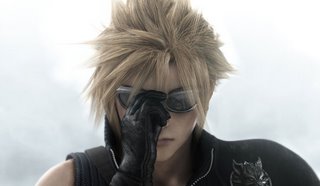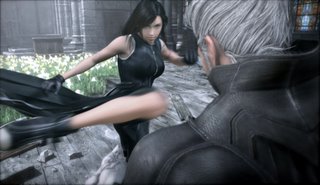Update (10 May, 2006): Alright, finally got the full range of images in here...
We're up to episode 9 now in
Ergo Proxy, and I'm sorry to say that I'm very disappointed (as are others, check out:
anime otaku for his take on this). The first epi

sode showed so much promise, with its darkly stylistic vision of the future and some of the most beautiful animation I have ever seen. Things picked up over the course of the next two episodes, as the show threw new twists at the viewer - from the appearance of Vincent's charm in Real's home, to Vincent's panicked escape from the Romdeau Proxy. And it all came to a very satisfying cliffhanger in episode 4, as Vincent fell from Romdeau and into an even more chaotic world.
Here we are, five episodes later, and I can't get over how much I don't care about the characters. The pacing and character development have left me utterly disconnected from the main cast. In fact, what surprises me most about this is that the only character I do like so far is one of the machines: Pino.

So let's talk Pino. What's not to like? She wears a rabbit suit, genuinely acts like a five-year-old kid, and is simply the cutest little robot ever. I'm not going as far as saying that I want her for a daughter, but she is simply adorable. And because we all know that looks aren't everything, she has personality to boot. While I felt absolutely nothing approaching sadness or loss when Queen died, I did appreciate the adorability of Pino as she touched Queen's face. Pino is just so likeable it almost makes me wonder why the series isn't centered on her more than the other characters.


Whereas Pino is adorable and personable, we have the rest of the cast. What started out as a cast of complex, real human beings has now become a sadly one-dimensional group. To begin with, let's examine Vincent Law. Originally he began as a bumbling immigrant with an unknown past - and now he has somehow morphed into an angst-driven whiner. See episode 9 if you want confirmation on that. The "cool factor" of the beginning episodes, where every time he opened his eyes was another "oh-my-god-he-is-so-cool" moment, is gone, and what we're left with is Vincent the amazing magical proxy boy. A proxy boy with an obsession problem, as I'm about to point out. His love for Real, while genuine in the series, has almost no basis for its existence. We barely see the two interact, except when Real first meets him and basically calls him an idiot. She only follows him for the most rational and emotionless reasons, yet somehow we are supposed to believe that in the approximate hour that Vincent has spent interacting with her he has fallen completely and hopelessly in love with her. Unless Real and Vincent have a much longer history that he somehow understood when he first met her, there isn't nearly enough support for this pairing. It's definitely natural, but not after fifteen minutes.
Speaking of Real - she and Raul, the two primary members of the supporting cast t hus far (well, Real will probably end up as a primary character, but so far she only serves as a figment of a love interest for Vincent), have displayed their own shortcomings over the past five episodes. Real was the snobby, yet stylish aristocrat, and Raul the ambitious, overly rational bureaucratic warrior. In both cases, neither character has been given enough screen time past the first four episodes for the viewers to fully appreciate the complexities of their characters.
hus far (well, Real will probably end up as a primary character, but so far she only serves as a figment of a love interest for Vincent), have displayed their own shortcomings over the past five episodes. Real was the snobby, yet stylish aristocrat, and Raul the ambitious, overly rational bureaucratic warrior. In both cases, neither character has been given enough screen time past the first four episodes for the viewers to fully appreciate the complexities of their characters.
Screen time is the main problem here - or rather the use of it. After what basically amounts to six episodes of Vincent, two of Real, and one of minor characters, we still have not seen many facets to any of the individuals except for Pino. All the members of the commune barely even seemed human, and as such I couldn't appreciate them, or their deaths. There is a definite emphasis in Ergo Proxy on story and style over character development, and it's hurting the feel of the show. The characters don't have any real driving motivations - there is a journey taking place, but unlike the one in Wolf's Rain where the characters are driven to it for their very purpose, in Ergo Proxy you can't help but feel (and Vincent says) that it's practically an afterthought. Okay, that might be a novel approach, but it fails in terms of holding attention and creating characters that viewers can connect with.


I began this season with so much anticipation - the first three or four episodes even confirmed my hopes...or so I thought. But in the end, Ergo Proxy has thus far failed to be the worthy successort to Samurai Champloo that I had hoped it would be, and instead has become just another mediocre science fiction romp.
Continue Reading...




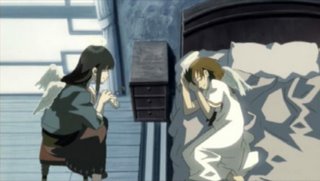

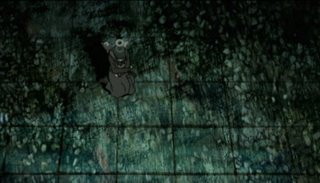 How do the two link together other than through the surface construct of the town? Mainly, it lies in the idea of the subconscious. In HWEW, there is only one "haibane" per se - the main character. He is alone in the town, the only being that does not belong. In Haibane Renmei, there are numerous haibane, and their interactions dictate how they act. This is a central difference, as well as a tie between the two. While HWEW concentrates on how the individual acts, Haibane Renmei serves to dissect how our relations with others form us and influence our decisions as people. The main character in HWEW acts alone, the haibane act together.
How do the two link together other than through the surface construct of the town? Mainly, it lies in the idea of the subconscious. In HWEW, there is only one "haibane" per se - the main character. He is alone in the town, the only being that does not belong. In Haibane Renmei, there are numerous haibane, and their interactions dictate how they act. This is a central difference, as well as a tie between the two. While HWEW concentrates on how the individual acts, Haibane Renmei serves to dissect how our relations with others form us and influence our decisions as people. The main character in HWEW acts alone, the haibane act together.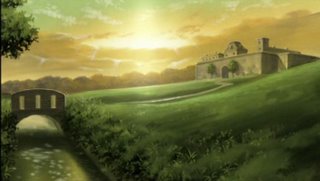 There is also the nature of the town itself. While in HWEW, we can surmise that the town is the main character's subconscious, in Haibane Renmei, the distinction is not so clear. There are many theories - perhaps the town is a type of purgatory, a place for people who have yet to become full and complete beings repent for their sins or reach a higher state of enlightenment, perhaps the town is a place for beings about to be sent to earth to interact and come to realize the sorts of trials they will experience on earth. Regardless, it is a place of interaction between numerous individuals, not the isolated tomb in HWEW.
There is also the nature of the town itself. While in HWEW, we can surmise that the town is the main character's subconscious, in Haibane Renmei, the distinction is not so clear. There are many theories - perhaps the town is a type of purgatory, a place for people who have yet to become full and complete beings repent for their sins or reach a higher state of enlightenment, perhaps the town is a place for beings about to be sent to earth to interact and come to realize the sorts of trials they will experience on earth. Regardless, it is a place of interaction between numerous individuals, not the isolated tomb in HWEW. "Armor won't save you, lay down your arms, or die!"
"Armor won't save you, lay down your arms, or die!" And then we see Kenshin lay waste to a half-dozen Shinsengumi in the span of twenty seconds. Beautiful.
And then we see Kenshin lay waste to a half-dozen Shinsengumi in the span of twenty seconds. Beautiful.
 The references to Spike's eyes, and the past/present natures they embody sends chills running down my spine every time I watch it. "She said you get the strangest feeling, looking into his eyes." And we also get yet another glimpse of Julia, that beautiful enigmatic figure that has been slowly built up over the past thirteen episodes - and here Watanabe executes with master form, building her up even more, into this melancholic angel. Gren's words epitomize what Julia is: "so sad...so beautiful..."
The references to Spike's eyes, and the past/present natures they embody sends chills running down my spine every time I watch it. "She said you get the strangest feeling, looking into his eyes." And we also get yet another glimpse of Julia, that beautiful enigmatic figure that has been slowly built up over the past thirteen episodes - and here Watanabe executes with master form, building her up even more, into this melancholic angel. Gren's words epitomize what Julia is: "so sad...so beautiful..."


 Fast forward six years - I'm attending my fourth anime expo, and o
Fast forward six years - I'm attending my fourth anime expo, and o
 Finally, there is the digitization of fansubs. This ties into the larger issue of overall digitization throughout the world. Online communication has already become the method of choice for most people, and many people prefer to get their information from online rather than print sources. The distribution of fansubs online has sucked many people into the anime scene, as people reacting to: "hey, free (albeit illegal) stuff," have over time come to love the art form and what it has to offer: appealing and moving stories.
Finally, there is the digitization of fansubs. This ties into the larger issue of overall digitization throughout the world. Online communication has already become the method of choice for most people, and many people prefer to get their information from online rather than print sources. The distribution of fansubs online has sucked many people into the anime scene, as people reacting to: "hey, free (albeit illegal) stuff," have over time come to love the art form and what it has to offer: appealing and moving stories.






